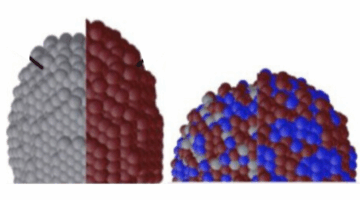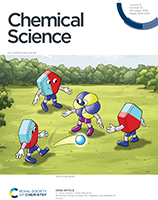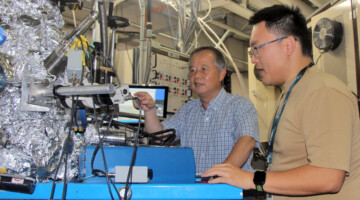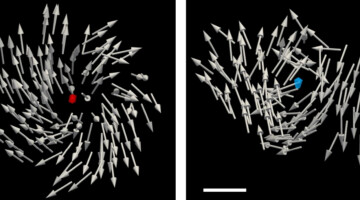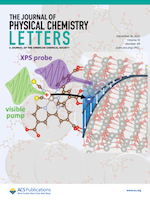Multimodal in situ x-ray experiments at the ALS revealed how copper–silver nanoparticle catalysts evolve during CO2 photoreduction. The findings, which demonstrate dynamic catalyst restructuring at the atomic level, provide crucial insights for enhancing the selectivity and efficiency of CO2 conversion into high-value chemicals. Read more »![]()
![]()
Multimetallic Systems Convey Cost-Effective Hydrogen Storage
A bimetallic material (Pd-Ni) produces hydrogen-active nanopockets that improve the efficiency and lower the cost of hydrogen storage systems. Mechanistic understanding of a Pd-Ni bimetallic system paves the way to design cost-effective hydrogen storage, opening new opportunities to develop reliable energy technologies necessary to advance the energy industry. Read more »![]()
![]()
Understanding the Role of Manganese in Fuel Production Catalysts
Using specialized equipment at the Advanced Light Source (ALS), including a custom-built reaction cell, researchers uncovered the role of manganese in cobalt manganese oxide catalysts used for fuel production. Read more »![]()
![]()
4f-Orbital Mixing Increases the Magnetic Susceptibility of Cp’3Eu
The ability to harness the 4f-orbital anisotropies and magnetic susceptibilities of lanthanide elements is key to their application in molecular magnetism, including as molecular qubits and single-molecule magnets. Here, 4f orbital mixing and its impact on the magnetic susceptibility of a trivalent Eu organometallic complex was analyzed experimentally. Read more »
“Computer Vision” Review of X-Ray Movies Leads to New Insights
Using a type of machine learning called “computer vision” to mine data from x-ray movies, researchers made new discoveries about the reactivity of a material in rechargeable batteries. The results suggest that optimizing the carbon layer thickness on the electrode surface could help researchers to design more efficient batteries. Read more »
HyMARC Aims to Hit Targets for Hydrogen Storage Using X-Ray Science
Understanding how materials absorb and release hydrogen is the focus of the Hydrogen Materials Advanced Research Consortium (HyMARC). At the ALS, the HyMARC Approved Program was recently renewed, underscoring the key role that soft x-ray techniques have played in addressing the challenges of hydrogen storage. Read more »
Will Chueh to Receive the 2023 Shirley Award
Will Chueh of Stanford University is the 2023 winner of the Shirley award for Outstanding Scientific Achievement at the ALS. His selection recognizes Chueh’s deep contributions in operando soft x-ray spectromicroscopy for imaging electrochemical redox phenomena—images and movies for battery and electrocatalytic reactions. Read more »
Imaging Topological Magnetic Monopoles in 3D
Researchers created topologically stable magnetic monopoles and imaged them in 3D with unprecedented spatial resolution using a technique developed at the ALS. The work enables the study of magnetic monopole behavior for both fundamental interest and potential use in information storage and transport applications. Read more »![]()
![]()
Watching Nanoparticle Chemistry and Structure Evolve
Using a multimodal approach, researchers learned how chemical properties correlate with structural changes during nanoparticle growth. The work will enable a greater understanding of the mechanisms affecting the durability of nanoparticles used to catalyze a broad range of chemical reactions, including clean-energy reactions. Read more »![]()
![]()
Nanoscale Confinement of Photo-Injected Electrons at Hybrid Interfaces
Picosecond time-resolved x-ray photoemission spectroscopy provides real-time electron distributions of donors and acceptors in a prototypical bipyridyl-ZnO hybrid light harvesting system. The measurements show that photo-injected electrons remain localized within the defect-rich surface region of the nanoporous ZnO substrate, revealing a challenge for the extraction of free charge carriers. Read more »
- 1
- 2
- 3
- …
- 5
- Next Page »
